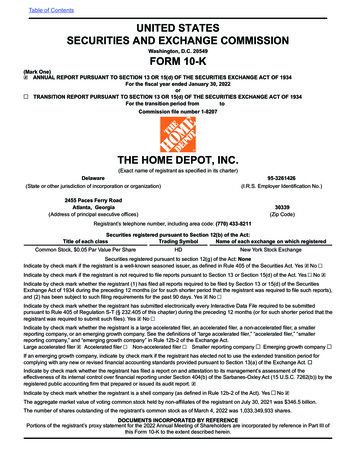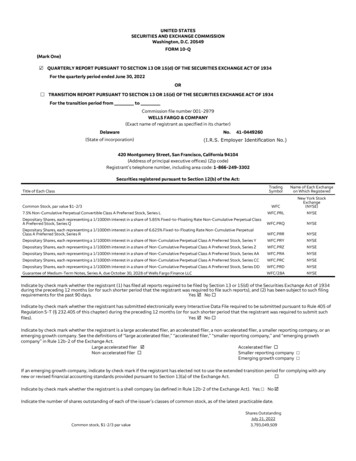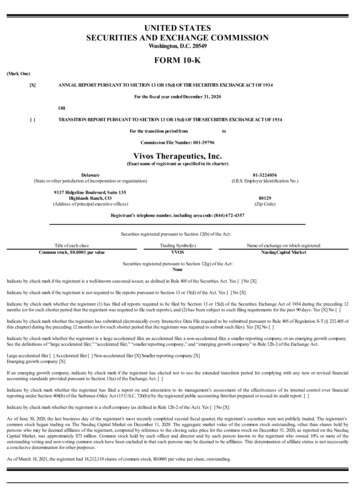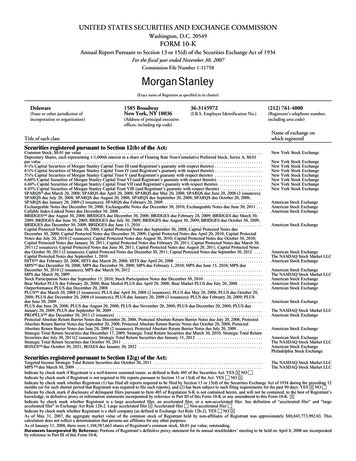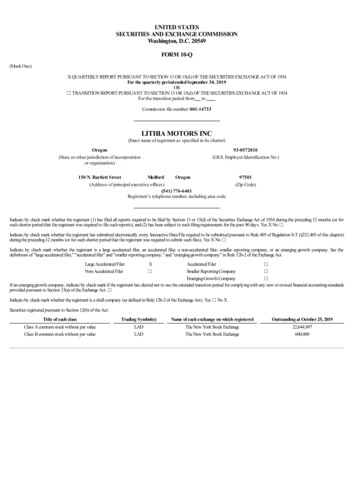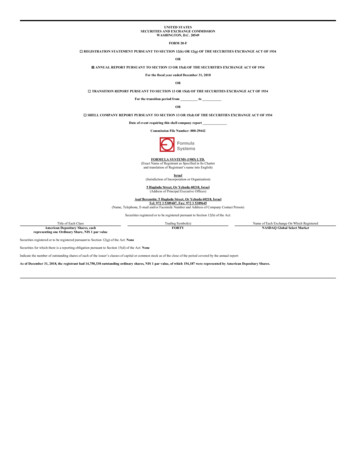
Transcription
UNITED STATESSECURITIES AND EXCHANGE COMMISSIONWASHINGTON, D.C. 20549FORM 20-F REGISTRATION STATEMENT PURSUANT TO SECTION 12(b) OR 12(g) OF THE SECURITIES EXCHANGE ACT OF 1934OR ANNUAL REPORT PURSUANT TO SECTION 13 OR 15(d) OF THE SECURITIES EXCHANGE ACT OF 1934For the fiscal year ended December 31, 2018OR TRANSITION REPORT PURSUANT TO SECTION 13 OR 15(d) OF THE SECURITIES EXCHANGE ACT OF 1934For the transition period from toOR SHELL COMPANY REPORT PURSUANT TO SECTION 13 OR 15(d) OF THE SECURITIES EXCHANGE ACT OF 1934Date of event requiring this shell company reportCommission File Number: 000-29442FORMULA SYSTEMS (1985) LTD.(Exact Name of Registrant as Specified in Its Charterand translation of Registrant’s name into English)Israel(Jurisdiction of Incorporation or Organization)5 Haplada Street, Or Yehuda 60218, Israel(Address of Principal Executive Offices)Asaf Berenstin; 5 Haplada Street, Or Yehuda 60218, IsraelTel: 972 3 5389487, Fax: 972 3 5389645(Name, Telephone, E-mail and/or Facsimile Number and Address of Company Contact Person)Securities registered or to be registered pursuant to Section 12(b) of the Act:Title of Each ClassAmerican Depositary Shares, eachrepresenting one Ordinary Share, NIS 1 par valueTrading Symbol(s)FORTYName of Each Exchange On Which RegisteredNASDAQ Global Select MarketSecurities registered or to be registered pursuant to Section 12(g) of the Act: NoneSecurities for which there is a reporting obligation pursuant to Section 15(d) of the Act: NoneIndicate the number of outstanding shares of each of the issuer’s classes of capital or common stock as of the close of the period covered by the annual report:As of December 31, 2018, the registrant had 14,750,338 outstanding ordinary shares, NIS 1 par value, of which 154,187 were represented by American Depositary Shares.
Indicate by check mark if the registrant is a well-known seasoned issuer, as defined in Rule 405 of the Securities Act.Yes No If this report is an annual or transition report, indicate by check mark if the registrant is not required to file reports pursuant to Section 13 or 15(d) of the Securities Exchange Act of 1934.Yes No Indicate by check mark whether the registrant (1) has filed all reports required to be filed by Section 13 or 15(d) of the Securities Exchange Act of 1934 during the preceding 12 months (or for such shorter period that theregistrant was required to file such reports), and (2) has been subject to such filing requirements for the past 90 days.Yes No Indicate by check mark whether the registrant has submitted electronically every Interactive Data File required to be submitted pursuant to Rule 405 of Regulation S-T (§ 232.405 of this chapter) during the preceding 12 months(or for such shorter period that the registrant was required to submit such files).Yes No Indicate by check mark whether the registrant is a large accelerated filer, an accelerated filer, a non-accelerated filer, or an emerging growth company. See the definitions of “large accelerated filer,” “accelerated filer,” and“emerging growth company” in Rule 12b-2 of the Exchange Act.Large accelerated filer Non-accelerated filer Accelerated filer Emerging Growth Company If an emerging growth company that prepares its financial statements in accordance with U.S. GAAP, indicate by check mark if the registrant has elected not to use the extended transition period for complying w)th any new orrevised financial accounting standards provided pursuant to Section 13(a) of the Exchange Act. Indicate by check mark which basis of accounting the registrant has used to prepare the financial statements included in this filing:U.S. GAAP International Financial Reporting Standards as issued by the International AccountingStandards Board If “Other” has been checked in response to the previous question, indicate by check mark which financial statement item the registrant has elected to follow.Item 17 Item 18 If this is an annual report, indicate by check mark whether the registrant is a shell company (as defined in Rule 12b-2 of the Exchange Act).Yes No Other
TABLE OF CONTENTSPART IITEM 1. IDENTITY OF DIRECTORS, SENIOR MANAGEMENT AND ADVISERSITEM 2. OFFER STATISTICS AND EXPECTED TIMETABLEITEM 3. KEY INFORMATIONITEM 4. INFORMATION ON THE COMPANYITEM 4A. UNRESOLVED STAFF COMMENTSITEM 5. OPERATING AND FINANCIAL REVIEW AND PROSPECTSITEM 6. DIRECTORS, SENIOR MANAGEMENT AND EMPLOYEESITEM 7. MAJOR SHAREHOLDERS AND RELATED PARTY TRANSACTIONSITEM 8. FINANCIAL INFORMATIONITEM 9. THE OFFER AND LISTINGITEM 10. ADDITIONAL INFORMATIONITEM 11. QUANTITATIVE AND QUALITATIVE DISCLOSURES ABOUT MARKET RISKITEM 12. DESCRIPTION OF SECURITIES OTHER THAN EQUITY SECURITIESITEM 13. DEFAULTS, DIVIDEND ARREARAGES AND DELINQUENCIESITEM 14. MATERIAL MODIFICATIONS TO THE RIGHTS OF SECURITY HOLDERS AND USE OF PROCEEDSITEM 15. CONTROLS AND PROCEDURESITEM 16A. AUDIT COMMITTEE FINANCIAL EXPERTITEM 16B. CODE OF ETHICSITEM 16C. PRINCIPAL ACCOUNTANT FEES AND SERVICESITEM 16D. EXEMPTIONS FROM THE LISTING STANDARDS FOR AUDIT COMMITTEESITEM 16E. PURCHASES OF EQUITY SECURITIES BY THE ISSUER AND AFFILIATED PURCHASERSITEM 16F. CHANGE IN REGISTRANT’S CERTIFYING ACCOUNTANTITEM 16G. CORPORATE GOVERNANCEITEM 17. FINANCIAL STATEMENTSITEM 18. FINANCIAL STATEMENTSITEM 19. 36136137138138138138139139140
Table of ContentsINTRODUCTIONThis annual report on Form 20-F contains various “forward-looking statements” within the meaning of Section 27A of the Securities Act of 1933, as amended, and Section 21E of the Securities Exchange Act of 1934, asamended, and the Private Securities Litigation Reform Act of 1995, as amended, with respect to our business, financial condition and results of operations. Such forward-looking statements reflect our current view with respectto future events and financial results. Statements which use the terms “anticipate,” “believe,” “expect,” “plan,” “intend,” “estimate” and similar expressions are intended to identify forward looking statements. We remindreaders that forward-looking statements are merely predictions and therefore inherently subject to uncertainties and other factors and involve known and unknown risks that could cause the actual results, performance, levels ofactivity, or our achievements, or industry results, to be materially different from any future results, performance, levels of activity, or our achievements expressed or implied by such forward-looking statements. Readers arecautioned not to place undue reliance on these forward-looking statements, which speak only as of the date hereof. Except as required by applicable law, including the securities laws of the United States, we undertake noobligation to publicly release any update or revision to any forward looking statements to reflect new information, future events or circumstances, or otherwise after the date hereof. We have attempted to identify significantuncertainties and other factors affecting forward-looking statements in the Risk Factors section that appears in Item 3 “Key Information— D. Risk Factors.”Our consolidated financial statements appearing in this annual report are prepared in U.S. dollars and in accordance with International Financial Reporting Standards, or IFRS, as issued by the International AccountingStandards Board, or IASB. All references in this annual report to “dollars” or “ ” are to U.S. dollars and all references in this annual report to “NIS” are to New Israeli Shekels. References to the Israeli CPI refer to the Israeliconsumer price index. References herein to the “ADSs” refer to our American Depositary Shares, each of which represents one ordinary share, par value NIS 1.0 per share, of our company.Statements made in this annual report concerning the contents of any contract, agreement or other document are summaries of such contracts, agreements or documents and are not complete descriptions of all of their terms. Ifwe have filed any of these documents as an exhibit to this annual report or to any previous filling with the Securities and Exchange Commission, or the SEC, you may read the document itself for a complete recitation of itsterms.As used in this annual report, references to “we,” “our,” “ours,” “our company,” “our Group” and “us” refer to Formula Systems (1985) Ltd. and its subsidiaries and affiliate company, unless otherwise indicated. Referencesto “Formula” refer to Formula Systems (1985) Ltd. alone. Our operations are currently conducted through our subsidiaries— Matrix IT Ltd., or Matrix, Sapiens International Corporation N.V., or Sapiens, Magic SoftwareEnterprises Ltd., or Magic Software, Michpal Micro Computers (1983) Ltd., or Michpal, and InSync Staffing Solutions, Inc., or InSync— and our affiliated company TSG Advanced IT Systems, Ltd., or TSG, in which we hold a50% share interest.All trademarks appearing in this annual report are the property of their respective holders.ii
Table of ContentsPART IITEM 1. IDENTITY OF DIRECTORS, SENIOR MANAGEMENT AND ADVISERSNot applicable.ITEM 2. OFFER STATISTICS AND EXPECTED TIMETABLENot applicable.ITEM 3. KEY INFORMATIONA.Selected Financial DataThe following tables present selected consolidated financial data as of the dates and for each of the periods indicated. Except where we have indicated otherwise, we have presented all of the consolidated financial information inthis document in accordance with IFRS as issued by the IASB. Historically, we had prepared our consolidated financial statements in accordance with United States generally accepted accounting principles, or U.S. GAAP, forall periods up to and including the year ended December 31, 2015. For the year ended December 31, 2016, we transitioned our reporting to IFRS. In order to comply with requirements of the SEC related to our transition to IFRS,we set the date of transition as January 1, 2015 and retrospectively applied IFRS as of that date and for the year ended December 31, 2015. Accordingly, we have presented herein consolidated statements of financial positiondata that complies with IFRS applicable as of January 1, 2015, in addition to as of December 31, 2015, 2016, 2017 and 2018. Our consolidated statements of profit or loss data presented herein in accordance with IFRS covers theyears ended December 31, 2016, 2017 and 2018, as well as the year ended December 31, 2015 (as adjusted from its prior presentation in accordance with U.S. GAAP).Pursuant to the transitional relief granted by the SEC in respect of the first-time adoption of IFRS, we have only presented statements of profit or loss data for each fiscal year in the four-year period ended December 31, 2018 inaccordance with IFRS. The selected statements of profit or loss data for the years ended December 31, 2016, 2017 and 2018, and the statements of financial position data as of December 31, 2017 and 2018, should be read inconjunction with, and are qualified in their entirety by, “Item 5. Operating and Financial Review and Prospects” and our audited consolidated financial statements and the notes thereto included in this annual report. The selectedstatements of profit or loss data for the year ended December 31, 2015, and the statements of financial position data as of January 1, 2015, and as of December 31, 2015 and 2016, have been derived from our previously filedaudited consolidated financial statements, which are not included in this annual report. Our historical results set forth herein are not necessarily indicative of our future results.Consolidated Statements of Profit or Loss DataYear ended December 31,20162017U.S. dollars in thousands (except per share data)20152018RevenuesCost of 58,3161,492,9881,159,676Gross profitResearch and development expenses, netSelling, marketing, general and administrative 6,82339,853184,164333,31241,223182,472Operating incomeFinancial expensesFinancial (29,870)8,751109,617(15,852)7,562Pre-tax income before share of profits of companies accounted for at equity, netTaxes on incomeShare of profits of companies accounted for at equity, 1,32724,301369Net incomeAttributable to:Equity holders of the CompanyNon-controlling 740,46215,571,838Earnings per share (basic)Earnings per share (diluted)Number of shares used in computing earnings per share (basic)Number of shares used in computing earnings per share (diluted)1
Table of ContentsConsolidated Statements of Financial Position Data:January 1,2015Total current assetsTotal long-term assets2015486,643588,98462,92258,728December 31,20162017(U.S. Dollars in 045PROPERTY, PLANTS AND EQUIPMENT, NET22,11122,00326,13029,80729,182INTANGIBLE ASSETS AND GOODWILL, NET534,219545,677623,808781,255790,901TOTAL 1Total current l long-term l equityTOTAL LIABILITIES AND 1,215,3921,354,5221,563,6371,664,161DividendsIn December 2018, Formula declared a cash dividend to its shareholders of 0.34 per share, which was paid in January 2019. The aggregate amount distributed by Formula was approximately 5.0 million.In May 2018, Formula declared a cash dividend to its shareholders of 0.34 per share, which was paid in June 2018. The aggregate amount distributed by Formula was approximately 5.0 million.In September 2017, Formula declared a cash dividend to its shareholders of 0.34 per share, which was paid in November 2017. The aggregate amount distributed by Formula was approximately 5.0 million.In December 2016, Formula declared a cash dividend to its shareholders of 0.48 per share, which was paid in January 2017. The aggregate amount distributed by Formula was approximately 7.1 million.In June 2016, Formula declared a cash dividend to its shareholders of 0.34 per share, which was paid in July 2016. The aggregate amount distributed by Formula was approximately 5.0 million.In January 2016, Formula declared a cash dividend to its shareholders of 0.34 per share, which was paid in February 2016. The aggregate amount distributed by Formula was approximately 5.0 million.In June 2015, Formula declared a cash dividend to its shareholders of 0.34 per share, which was paid in August 2015. The aggregate amount distributed by Formula was approximately 5.0 million.Cash dividends may be declared and paid in NIS or dollars. Dividends to the holders of Formula’s American Depositary Shares, or ADSs, are paid by the depositary of the ADSs, for the benefit of owners of ADSs. If a dividendis declared and paid in NIS in Israel, the NIS amount is converted into, and paid out in, dollars by the depositary of the ADSs.2
Table of ContentsB.Capitalization and IndebtednessNot applicable.C.Reasons for the Offer and Use of ProceedsNot applicable.D.Risk FactorsOur business prospects, operating results and financial condition could be seriously harmed due to any of the following risks. Additional risks and uncertainties that we are not aware of or that we currently believe are immaterialmay also adversely affect our business prospects, financial condition, and results of operations. The trading prices of our ordinary shares and ADSs could decline due to any of these risks, and you may lose all or part of yourinvestment.Risks Related to Our Business and Our IndustryRapid technological changes may adversely affect the market acceptance of our products and services, and our business, results of operations and financial condition could be adversely affected.We compete in markets that are characterized by rapid technological changes. Other companies are also seeking to offer software solutions and other products and services in our markets, including enterprise mobility solutions,digital transformation solutions, big data and data analytics solutions, Internet of Things (IOT) solutions, cyber solutions, business intelligence (BI) solutions, AI and machine learning solutions, internet-related solutions, such ascloud computing and complementary services and business solutions for the insurance and financial services industry. These companies may develop technological or business model innovations or offer services in the marketsthat we seek to address that are, or are perceived to be, equivalent or superior to our products and services. Furthermore, many of our smaller competitors have been acquired and may be acquired in the future by largercompetitors, which provides such smaller competitors with greater resources and potentially a larger client base for which they can develop solutions. Our customers or potential customers may prefer suppliers that are largerthan us, are better known in the market or that have a greater global reach.In addition, our customers’ business models may change in ways that we do not anticipate and these changes could reduce or eliminate our customers’ needs for our products and services. Our operating results depend on ourability to adapt to market changes and develop and introduce new products and services into existing and emerging markets.The introduction of new technologies, devices and business models could render existing products and services obsolete and unmarketable and could exert price pressures on our products and services. Our future success willdepend upon our ability to address the increasingly sophisticated needs of our customers by: Supporting existing and emerging hardware, software, databases and networking platforms; and Developing and introducing new and enhanced software development technology and applications that keep pace with such technological developments, emerging new product markets and changing customerrequirements.The market for software solutions and related services and for business solutions is highly competitive. Many of our smaller competitors have been acquired by larger competitors, which provides such smaller competitors withgreater resources and potentially a larger client base for which they can develop solutions. Our customers or potential customers may prefer suppliers that are larger than us, are better known in the market, or that have a greaterglobal reach. In addition, we and some of our competitors have developed business models to allow customers to outsource their core systems to external providers (known as BPO). We are seeking to partner with BPOproviders, but there can be no assurance that such BPO providers will adopt our solutions rather than those of our competitors. Determinations by current and potential customers to use BPO providers that do not use oursolutions may result in the loss of such customers and limit our ability to gain new customers.Adapting to evolving technologies can require substantial financial investments, distract management and adversely affect the demand for our existing products and services.Adapting to evolving technologies may require us to invest a significant amount of resources, time and attention into the development, integration, support and marketing of products and services that work with or utilize thosetechnologies. For example, the acceptance and growth of cloud computing, enterprise mobility, security and cyber and digital are examples of rapid technological changes which we have adapted into our products, packagedsoftware solution and software services offerings. Developing and implementing cloud computing, enterprise mobility, security and cyber and digital into certain of our software solution models and software services offeringsrequired us to make substantial investments and required significant attention from our management to refine our business strategies to include the delivery of these solutions. As the market continues to adopt new technologies,we expect to continue to make substantial investments in our software solutions, system integrations and professional services related to these changing technologies. Even if we succeed in adapting to a new technology bydeveloping attractive products and services and successfully bringing them to market, there is no assurance that the new product or service will have a positive impact on our financial performance and could even result in lowerrevenue, lower margins and higher costs and therefore could negatively impact our financial performance.3
Table of ContentsUnfavorable national or global economic conditions could adversely affect our business, operating results and financial condition.During periods of slowing economic activity our customers may reduce their demand for our products, technology and software services, which would reduce our sales, and our business, operating results and financial conditionmay be adversely affected. Economies throughout the world currently face a number of challenges, including threatened sovereign defaults, credit downgrades, restricted credit for businesses and consumers and potentiallyfalling demand for a variety of products and services. Notwithstanding the improved economic conditions in some of our markets, many companies are still cutting back expenditures or delaying plans to add additional personnelor systems. Any worsening of global economic conditions could result in longer sales cycles, slower adoption of new technologies and increased price competition for our products and services. We could also be exposed tocredit risk and payment delinquencies on our accounts receivable, which are not covered by collateral. Any of these events would likely harm our business, operating results and financial condition.These developments, or the perception that any of them could occur, could have a material adverse effect on global economic conditions and the stability of global financial markets, and could significantly reduce global marketliquidity and restrict the ability of key market participants to operate in certain financial markets. Asset valuations, currency exchange rates and credit ratings may be especially subject to increased market volatility.The U.S. Tax Cuts and Jobs Act of 2017, or the U.S. Tax Act, enacted in December 2017, introduced significant changes to the U.S. Internal Revenue Code. The primary impact of the U.S. Tax Act on us was a reduction of oureffective tax rate in the U.S. The expected impact of the U.S. Tax Act may differ from the tax expense that we actually incur, due to, among other things, possible changes in the interpretations and assumptions made by us as aresult of additional information, additional guidance that may be issued by the U.S. Department of Treasury, the Internal Revenue Service, or IRS, or other standard-setting bodies. There may be additional tax effects of the U.S.Tax Act that may impact our future financial statements once additional laws, regulations, and/or guidance are enacted or issued (as applicable), which we will account for at that time.If global economic and market conditions, or economic conditions in the United States, Europe or Asia or other key markets, remain uncertain (where applicable) or weaken, our business, operating results and financial conditionmay be adversely affected.Our development cycles are lengthy, we may not have the resources available to complete development of new, enhanced or modified, solutions and we may incur significant expenses before we generate revenues, ifany, from our solutions.Because certain of our solutions are complex and require rigorous testing, development cycles can be lengthy, taking us up to two years to develop and introduce new, enhanced or modified solutions. Moreover, developmentprojects can be technically challenging and expensive. The nature of these development cycles may cause us to experience delays between the time we incur expenses associated with research and development and the time wegenerate revenues, if any, from such expenses. We may also not have sufficient funds or other resources to make the required investments in product development. Furthermore, we may invest substantial resources in thedevelopment of solutions that do not achieve market acceptance or commercial success. Even where we succeed in our sales efforts and obtain new orders from customers, the complexity involved in delivering our solutions tosuch customers makes it more difficult for us to consummate delivery in a timely manner and to recognize revenue and maximize profitability. Failure to deliver our solutions in a timely manner could result in ordercancellations, damage our reputations and require us to indemnify our customers. Any of these risks relating to our lengthy and expensive development cycle could have a material adverse effect on our business, financialconditions and results of operations.Our sales cycle is variable, depends upon many factors outside our control, and could cause us to expend significant time and resources prior to earning associated revenues.The typical sales cycle for certain of our solutions and services is lengthy and unpredictable, requires pre-purchase evaluation by a significant number of persons in our customers’ organizations, and often involves a significantoperational decision by our customers. Our sales efforts involve educating our customers and industry analysts and consultants about the use and benefits of our solutions, including the technical capabilities of our solutions andthe efficiencies achievable by organizations deploying our solutions. Customers typically undertake a significant evaluation process, which frequently involves not only our solutions, but also those of our competitors and canresult in a lengthy sales cycle. Our sales cycle for new customers is typically one year to two years and can extend even longer in some cases. We spend substantial time, effort and money in our sales efforts without anyassurance that such efforts will produce any sales.4
Table of ContentsInvestment in highly skilled research and development and customer support personnel is critical to our ability to develop and enhance our solutions and support our customers, but an increase in such investmentmay reduce our profitability.As a provider of software solutions that rely upon technological advancements, we rely heavily on our research and development activities to remain competitive. We consequently depend in large part on the ability to attract,train, motivate and retain highly skilled information technology professionals for our research and development team, particularly individuals with knowledge and experience in the insurance industry. Because our softwaresolutions are highly complex and are generally used by our customers to perform critical business functions, we also depend heavily on other skilled technology professionals to provide ongoing support to our customers. Skilledtechnology professionals are often in high demand and short supply. If we are unable to hire or retain qualified research and development personnel and other technology professionals to develop, implement and modify oursolutions, we may be unable to meet the needs of our customers. Even if we succeed in retaining the necessary skilled personnel in our research and development and customer support efforts, our investments in our personneland product development efforts increase our costs of operations and thereby reduce our profitability, unless accompanied by increased revenues. Given the highly competitive industry in which we operate, we may not succeedin increasing our revenues in line with our increasing investments in our personnel and research and development efforts.Furthermore, as we seek to expand the marketing and offering of our products and services into new territories, it requires the retention of new, additional skilled personnel with knowledge of the particular market and applicableregulatory regime. Such skilled personnel may not be available at a reasonable cost relative to the additional revenues that we expect to generate in those territories, or may not be available at all. In particular, wage costs inlower-cost markets where we have recently added personnel, such as India, are increasing and we may need to increase the levels of our employee compensation more rapidly than in the past to remain competitive. The transitionof projects to new locations may also lead to business disruptions due to differing levels of employee knowledge and organizational and leadership skills. Although we have never experienced an organized labor dispute, strike orwork stoppage, any such occurrence, including in connection with unionization efforts, could disrupt our business and operations and harm our financial condition.If our products and services fail to compete successfully with those of our competitors, we may have to reduce the prices of our products and services, which, in turn, may adversely affect our business.We face competition, both in Israel and internationally, from a variety of companies, including companies with significantly greater resources than ours who are likely to enjoy substantial competitive advantages, including: longer operating histories; closer proximity to future markets; greater financial, technical, marketing and other resources; cheaper costs, including labor cost; political leverage; greater name recognition; well-established relationships with our current and potential clients; and a broader range of products and services.Both Matrix’s and Magic Software’s principal domestic competitors in the Israeli market are Israeli IT services companies and systems integrators, the large
SECURITIES AND EXCHANGE COMMISSION WASHINGTON, D.C. 20549 FORM 20-F REGISTRATION STATEMENT PURSUANT TO SECTION 12(b) OR 12(g) OF THE SECURITIES EXCHANGE ACT OF 1934 . with respect to our business, financial condition and results of operations. Such forward-looking statements reflect our current view with respect . net 15,123 22,328 .
